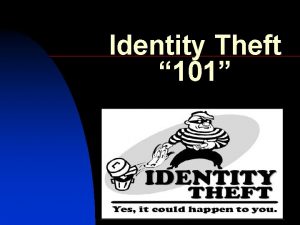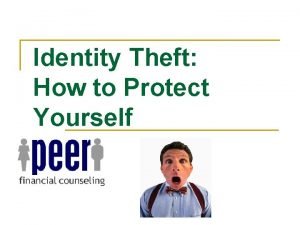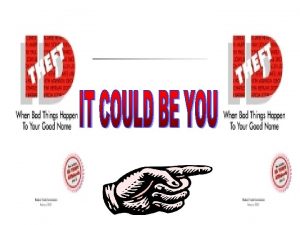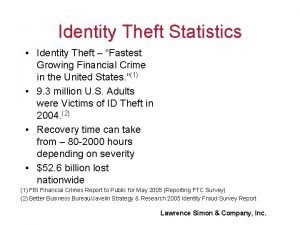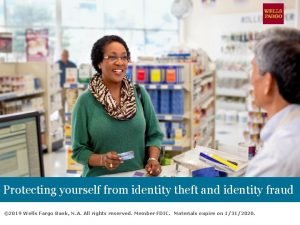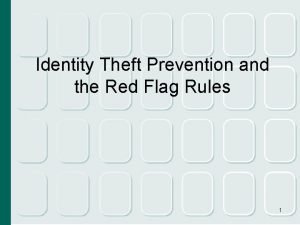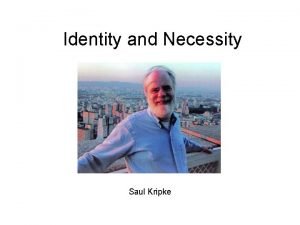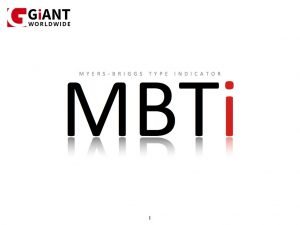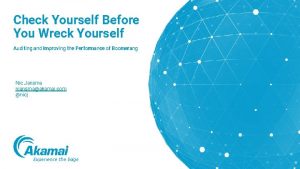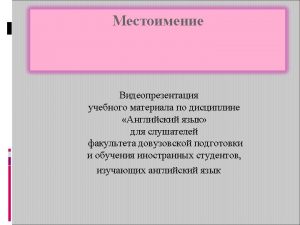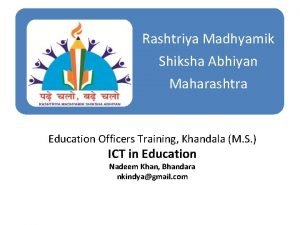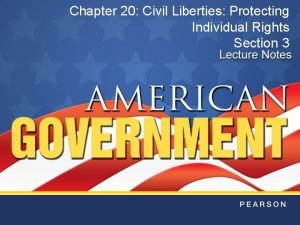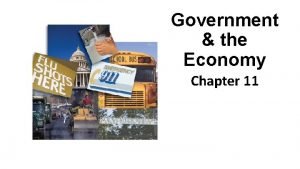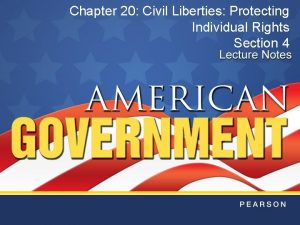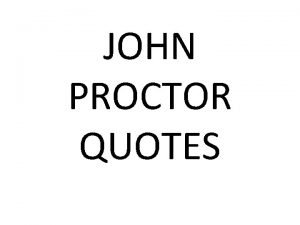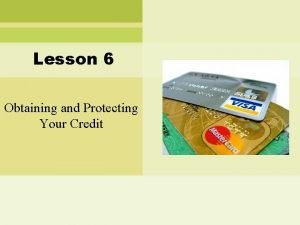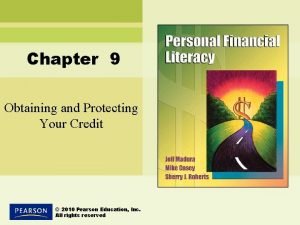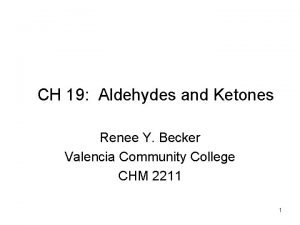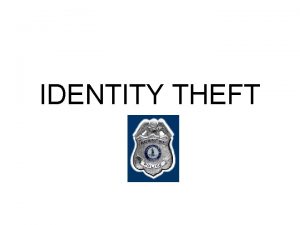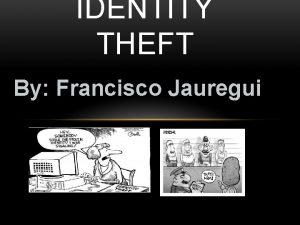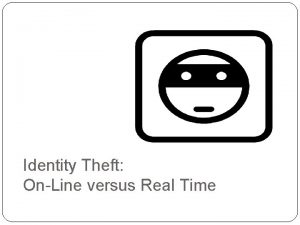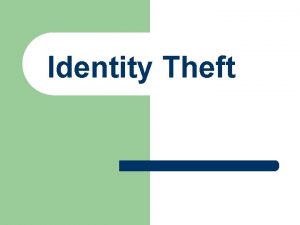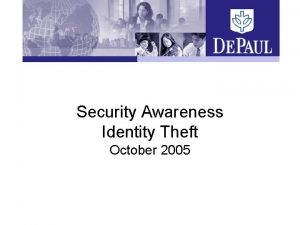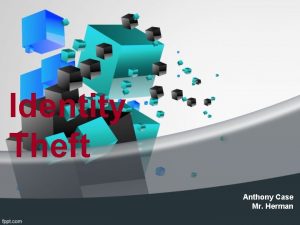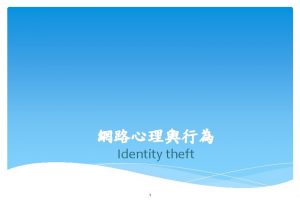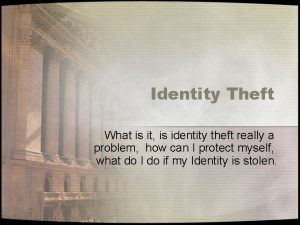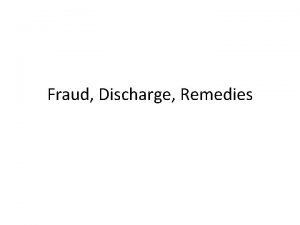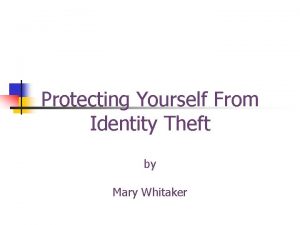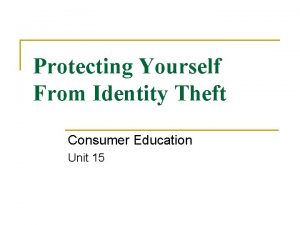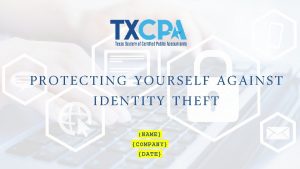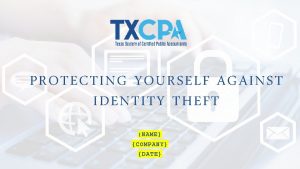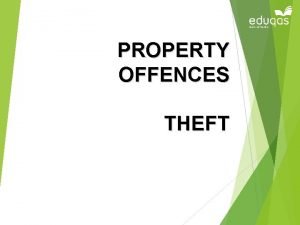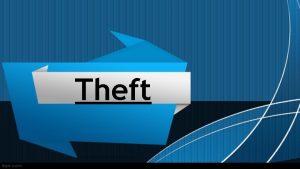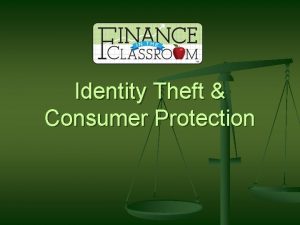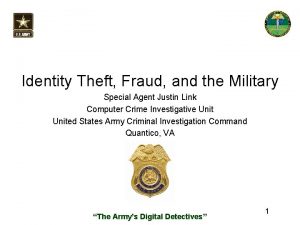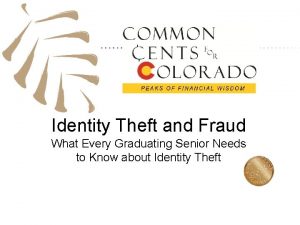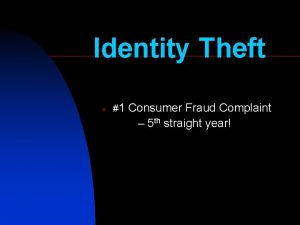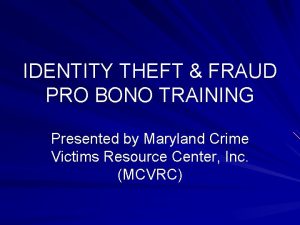Protecting Yourself from Fraud including Identity Theft Advanced

























- Slides: 25

Protecting Yourself from Fraud including Identity Theft Advanced Level

2. 6. 4. G 1 Fraud – an intentional effort to deceive another individual for personal gain Arrests for crimes not committed Damaged financial security Tarnished credit reports Compromised health © Take Charge Today – August 2013 – Protecting Yourself From Fraud – Slide 2 Funded by a grant from Take Charge America, Inc. to the Norton School of Family and Consumer Sciences Take Charge America Institute at the University of Arizona

2. 6. 4. G 1 Common Types of Fraud Identity Theft When another’s personal information is used without their permission Communications Occurs via mass marketing, mail, wire, telephone, Internet, etc. to deceitfully get money from people Identity theft was the largest consumer fraud complaint reported to the Federal Trade Commission in 2010 © Take Charge Today – August 2013 – Protecting Yourself From Fraud – Slide 3 Funded by a grant from Take Charge America, Inc. to the Norton School of Family and Consumer Sciences Take Charge America Institute at the University of Arizona

2. 6. 4. G 1 Common Types of Fraud Credit Applying for and modifying credit (most common involves mortgages) Investment Investors are deceived by individuals claiming to be financial advisors or have an investment guaranteed to make money Tax Scammers making claims that a person may be exempt from paying taxes Do you know anyone that has been a victim of fraud? © Take Charge Today – August 2013 – Protecting Yourself From Fraud – Slide 4 Funded by a grant from Take Charge America, Inc. to the Norton School of Family and Consumer Sciences Take Charge America Institute at the University of Arizona

2. 6. 4. G 1 Costs money How does fraud negatively impact financial wellbeing? Anxiety Stress Time © Take Charge Today – August 2013 – Protecting Yourself From Fraud – Slide 5 Funded by a grant from Take Charge America, Inc. to the Norton School of Family and Consumer Sciences Take Charge America Institute at the University of Arizona

2. 6. 4. G 1 Solve the Mystery – Act 2 Listen carefully and take notes to help Lucy find the person who stole her identity © Take Charge Today – August 2013 – Protecting Yourself From Fraud – Slide 6 Funded by a grant from Take Charge America, Inc. to the Norton School of Family and Consumer Sciences Take Charge America Institute at the University of Arizona

2. 6. 4. G 1 Four Suspects… The inspector has identified 4 suspects in Lucy’s case d r a t s l Mu e n o ugh l o r o h C t hed ail Searc tgoing m ou Lucy’s Mrs. Peacock Guessed L ucy’s PIN numb er Mrs. Wh it e Searche d throug Lucy’s d h iscarded mail m u l P r o s s e f Pro ne y’s onli c u L d e h c r a Se site banking web Which type of fraud has been committed against Lucy? © Take Charge Today – August 2013 – Protecting Yourself From Fraud – Slide 7 Funded by a grant from Take Charge America, Inc. to the Norton School of Family and Consumer Sciences Take Charge America Institute at the University of Arizona

2. 6. 4. G 1 How Does Fraud Occur? Failed Promises Accessing Personal Information Name Bank Account Numbers Credit Card Numbers Address & Telephone Number Personal Information Birthdate Social Security Number Driver’s License Number What can a scammer do if they gain access to your information? © Take Charge Today – August 2013 – Protecting Yourself From Fraud – Slide 8 Funded by a grant from Take Charge America, Inc. to the Norton School of Family and Consumer Sciences Take Charge America Institute at the University of Arizona

2. 6. 4. G 1 Personal Information Search your purses, wallets and backpacks. What are you carrying with you right now that reveals personal information? Drivers license Debit & credit cards Electronic devices Identification cards © Take Charge Today – August 2013 – Protecting Yourself From Fraud – Slide 9 Funded by a grant from Take Charge America, Inc. to the Norton School of Family and Consumer Sciences Take Charge America Institute at the University of Arizona

2. 6. 4. G 1 How Thieves Access Personal Information Stealing a purse, wallet, financial records, mail, etc. Diverting mail Skimming credit and debit card information Phishing for personal information via email Hacking a computer to install spyware How did the scammer access Lucy’s information? © Take Charge Today – August 2013 – Protecting Yourself From Fraud – Slide 10 Funded by a grant from Take Charge America, Inc. to the Norton School of Family and Consumer Sciences Take Charge America Institute at the University of Arizona

2. 6. 4. G 1 Protecting Yourself From Fraud You are better off in a community than by yourself. • Government creates and manages agencies designed to protect you from fraud But, you are also responsible for yourself. • The best way to avoid fraud it to be alert to the risk and protect yourself © Take Charge Today – August 2013 – Protecting Yourself From Fraud – Slide 11 Funded by a grant from Take Charge America, Inc. to the Norton School of Family and Consumer Sciences Take Charge America Institute at the University of Arizona

2. 6. 4. G 1 Protect Your Personal Information Don’t carry your Social Security Card Sign credit and debit cards with signature and “Please See ID” Memorize and use difficult PIN numbers Shred personal documents before discarding them Keep personal records in a secure location Deposit outgoing mail in a secure post office collection box Be careful of what personal information is posted on the Internet © Take Charge Today – August 2013 – Protecting Yourself From Fraud – Slide 12 Funded by a grant from Take Charge America, Inc. to the Norton School of Family and Consumer Sciences Take Charge America Institute at the University of Arizona

2. 6. 4. G 1 Check Your Credit Reports • Immediately dispute errors Evaluate Situations • Verify sources requesting information Monitor Financial Information • Consistently monitor information such as credit statements, depository institution statements, etc © Take Charge Today – August 2013 – Protecting Yourself From Fraud – Slide 13 Funded by a grant from Take Charge America, Inc. to the Norton School of Family and Consumer Sciences Take Charge America Institute at the University of Arizona

2. 6. 4. G 1 Be Careful When Using the Internet Look for “https” or a picture of a lock Keep usernames and passwords safe Use a credit card when making online purchases Search for your name Once information is posted online, it can’t be taken back! Use privacy settings on social networking sites © Take Charge Today – August 2013 – Protecting Yourself From Fraud – Slide 14 Funded by a grant from Take Charge America, Inc. to the Norton School of Family and Consumer Sciences Take Charge America Institute at the University of Arizona

2. 6. 4. G 1 Use updated antivirus and antispyware software Practice electronic device safety Do not click on links found in pop-up advertisements or suspicious email Watch for strange actions that may indicate spyware © Take Charge Today – August 2013 – Protecting Yourself From Fraud – Slide 15 Funded by a grant from Take Charge America, Inc. to the Norton School of Family and Consumer Sciences Take Charge America Institute at the University of Arizona

2. 6. 4. G 1 Credit and Debit Cards Credit Cards Maximum liability is $50 Debit Cards Liability depends on how quickly No liability if a lost card is reported the card is reported and depository institution policies before being fraudulently used No liability if the card number is used, but not the card itself Ranges from $0 -unlimited! Use a credit card instead of a debit card for online purchases! © Take Charge Today – August 2013 – Protecting Yourself From Fraud – Slide 16 Funded by a grant from Take Charge America, Inc. to the Norton School of Family and Consumer Sciences Take Charge America Institute at the University of Arizona

2. 6. 4. G 1 What could Lucy have done to minimize her risk? § § § Mail her documents from a secure post office location Use a PIN number that is not easy to guess Shred documents that contain personal information Use secure websites and computers Use privacy settings on social networking sites Never give personal information out via email © Take Charge Today – August 2013 – Protecting Yourself From Fraud – Slide 17 Funded by a grant from Take Charge America, Inc. to the Norton School of Family and Consumer Sciences Take Charge America Institute at the University of Arizona

2. 6. 4. G 1 Fraud Protection Services Companies may offer various types of services including: Fraud monitoring and detection Cost recovery if fraud occurs Legal counsel if fraud occurs You are your best advocate! Closely evaluate services to know what is covered, fees and company reputation © Take Charge Today – August 2013 – Protecting Yourself From Fraud – Slide 18 Funded by a grant from Take Charge America, Inc. to the Norton School of Family and Consumer Sciences Take Charge America Institute at the University of Arizona

2. 6. 4. G 1 Act Immediately if… Recognize Fraud Early A business that has taken your money won’t return your calls Unfamiliar or unrecognizable charges You are denied credit Mail is missing Errors in your credit report Could Lucy have recognized theft earlier? © Take Charge Today – August 2013 – Protecting Yourself From Fraud – Slide 19 Funded by a grant from Take Charge America, Inc. to the Norton School of Family and Consumer Sciences Take Charge America Institute at the University of Arizona

2. 6. 4. G 1 If You Are a Victim Act Immediately Keep detailed records File a report with your local law enforcement Report to the appropriate federal agency The Stop Fraud website will tell you which agency to report to and provide specific tips depending on the type of fraud What steps should Lucy take? © Take Charge Today – August 2013 – Protecting Yourself From Fraud – Slide 20 Funded by a grant from Take Charge America, Inc. to the Norton School of Family and Consumer Sciences Take Charge America Institute at the University of Arizona

2. 6. 4. G 1 Most Common Government Protection Agencies Federal Trade Commission Prevent business practices that are anticompetitive, deceptive or unfair to consumers Consumer Makes markets for consumer financial products and Financial Protection Bureau services work for Americans Federal Drug Administration Federal Communications Commission Protects the public health Regulates interstate and international communication © Take Charge Today – August 2013 – Protecting Yourself From Fraud – Slide 21 Funded by a grant from Take Charge America, Inc. to the Norton School of Family and Consumer Sciences Take Charge America Institute at the University of Arizona

2. 6. 4. G 1 Most Common Government Protection Agencies US Securities and Exchange Commission Internal Revenue Service Federal Bureau of Investigation Protect investors and maintain fair, orderly and efficient financial markets Enforce tax laws Protects the United States and its citizens © Take Charge Today – August 2013 – Protecting Yourself From Fraud – Slide 22 Funded by a grant from Take Charge America, Inc. to the Norton School of Family and Consumer Sciences Take Charge America Institute at the University of Arizona

2. 6. 4. G 1 Solve the Mystery Answer Questions Correctly to Earn Clues! © Take Charge Today – August 2013 – Protecting Yourself From Fraud – Slide 23 Funded by a grant from Take Charge America, Inc. to the Norton School of Family and Consumer Sciences Take Charge America Institute at the University of Arizona

2. 6. 4. G 1 Who is Lucy’s Scammer? – Act 3 Make Your Guess! d r a t s el Mu Colon ugh o r h t il hed a M c r r m s a. g e S n i o g t u o Peacock Lucy’s Guessed L ucy’s PIN numb er Mrs. Wh it e Searche d throug Lucy’s d h iscarded mail m u l P r o s s e f o Pr line cy’s on u L d e h c r a e S site banking web © Take Charge Today – August 2013 – Protecting Yourself From Fraud – Slide 24 Funded by a grant from Take Charge America, Inc. to the Norton School of Family and Consumer Sciences Take Charge America Institute at the University of Arizona

2. 6. 4. G 1 FRAUD OF THE MONTH ACTIVITY Don‘t Let It Happen To YOU! 15 Minutes: Read your Article and Complete don’t Let it Happen To You Share with Your Table: Share three important tips to protect yourself from Fraud & Share with class © Take Charge Today – August 2013 – Protecting Yourself From Fraud – Slide 25 Funded by a grant from Take Charge America, Inc. to the Norton School of Family and Consumer Sciences Take Charge America Institute at the University of Arizona
 How do fraud symptoms help in detecting fraud
How do fraud symptoms help in detecting fraud Identity theft 101
Identity theft 101 Identity theft
Identity theft Identity theft and assumption deterrence act
Identity theft and assumption deterrence act Identity theft graph
Identity theft graph Wells fargo identity theft repair kit
Wells fargo identity theft repair kit Identity theft prevention program
Identity theft prevention program Synthetic statement example
Synthetic statement example Identity fraud
Identity fraud Know yourself to lead yourself
Know yourself to lead yourself Check yourself before you wreck yourself origin
Check yourself before you wreck yourself origin Himself herself itself
Himself herself itself Youtube yourself broadcast yourself
Youtube yourself broadcast yourself A.backtoschool
A.backtoschool Chapter 20 civil liberties protecting individual rights
Chapter 20 civil liberties protecting individual rights Carbamate protecting group
Carbamate protecting group Protecting consumers savers and investors examples
Protecting consumers savers and investors examples Chapter 20 civil liberties protecting individual rights
Chapter 20 civil liberties protecting individual rights Chapter 20 civil liberties protecting individual rights
Chapter 20 civil liberties protecting individual rights Bitter woman quotes
Bitter woman quotes Which of the following is not part of overall biodiversity
Which of the following is not part of overall biodiversity Reactions of aldehydes and ketones summary
Reactions of aldehydes and ketones summary Obtaining and protecting your credit
Obtaining and protecting your credit Chapter 9 obtaining and protecting your credit
Chapter 9 obtaining and protecting your credit Species diversity
Species diversity Uses of ketones
Uses of ketones

